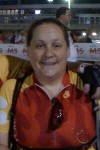billbolton wrote:This web site contains a summary of the claims made by Buteyko practitioners regarding treating OSA (
Obstructive Sleep Apnea).
http://www.asthmacare.us/ac_blog/?p=480
Note carefully that the
independent references cited for supporting the claims are in fact all releated to CSA (
Central Sleep Apnea),
NOT OSA
Hey Bill - thanks for posting how Butekyo works you did me a favour -
The research by Naughton (see ref. in Why apnea occurs section above) shows that the mechanism by which CPAP improves apnea is by raising the pressure in the airways, which reduces the breathing volume (reduces hyperventilation) and increases the CO2 level above the threshold for apnea and keeps it there whilst the machine is applied.
The Buteyko breathing technique aims to teach you to do this for yourself by correcting the hyperventilation breathing pattern that is associated with snoring and apnea. You retrain your breathing when you are awake, reducing your breathing volume, increasing the airway CO2 towards normal, which can prevent apnea and results in quieter breathing. Oxygenation is improved. Practice of the breathing exercises can effect a resetting of the automatic respiratory drive to the correct rate. This carries over into the sleep stage.
By using the Buteyko exercises, people commonly report reduced nasal blockage, snoring and sleep apnea within a few days. Weight normalization is commonly experienced. Improved oxygenation reduces fatigue and daytime drowsiness. The cardiovascular system benefits. Improvements in exercise capacity and resting and performance heart rate are reported. Heart rate recovery post exercise is enhanced.
Why apnea occurs
In conventional medicine sleep apnea is still misunderstood for a large part.
According to Professor Buteyko’s theory , hyperventilation is considered to be the fundamental cause of OSA. He argues that apneas or pauses in breathing are the body’s defense mechanism against the excessive loss of carbon dioxide due to hyperventilation and consequent hypoxia (lack of oxygen).
Buteyko, Naughton and Javaheri* have shown that sleep apnea happens subsequent to over-breathing. Heavy breathing and snoring is associated with a drop in airway carbon dioxide levels. If the CO2 concentration goes below a critical level, the “apneic threshold”, apnea occurs. Breathing stops temporarily due to this dangerous imbalance in blood gases. In some cases this is accompanied by collapsing of the airway. These processes allow the CO2 levels to return to normal. Then breathing recommences usually with a snort, sigh or sharp intake of breath. Both the lack of oxygen during the apnea and the inhibition of oxygenation during the hyperventilation, (Bohr effect) can lead to hypoxia. Prolonged periods of hyperventilation may result in severe tiredness and exhaustion and can lead to temporary paralysis of muscles in different parts of the body, including throat musculature. Poorly oxygenated tissues lack tone.
p.s. The formula - You've had enough of your cpap machine or you are looking for an alternative - Do the 5 day Butekyo course - have another sleep study done - get your { AHI/RAI Scale }
You then have your answer as proved by science.
Have a great day I know I will - Chopper.













